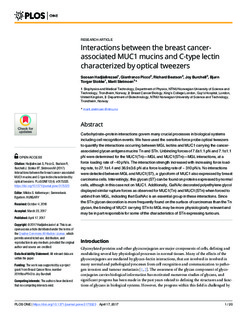| dc.contributor.author | Hadjialirezaei, Soosan | |
| dc.contributor.author | Picco, Gianfranco | |
| dc.contributor.author | Beatson, Richard | |
| dc.contributor.author | Burchell, Joy | |
| dc.contributor.author | Stokke, Bjørn Torger | |
| dc.contributor.author | Sletmoen, Marit | |
| dc.date.accessioned | 2017-10-26T07:22:18Z | |
| dc.date.available | 2017-10-26T07:22:18Z | |
| dc.date.created | 2017-10-09T13:25:33Z | |
| dc.date.issued | 2017 | |
| dc.identifier.issn | 1932-6203 | |
| dc.identifier.uri | http://hdl.handle.net/11250/2462240 | |
| dc.description.abstract | Carbohydrate–protein interactions govern many crucial processes in biological systems including cell recognition events. We have used the sensitive force probe optical tweezers to quantify the interactions occurring between MGL lectins and MUC1 carrying the cancer-associated glycan antigens mucins Tn and STn. Unbinding forces of 7.6±1.1 pN and 7.1±1.1 pN were determined for the MUC1(Tn)—MGL and MUC1(STn)—MGL interactions, at a force loading rate of ~40 pN/s. The interaction strength increased with increasing force loading rate, to 27.1±4.4 and 36.9±3.6 pN at a force loading rate of ~ 310 pN/s. No interactions were detected between MGL and MUC1(ST), a glycoform of MUC1 also expressed by breast carcinoma cells. Interestingly, this glycan (ST) can be found on proteins expressed by normal cells, although in this case not on MUC1. Additionally, GalNAc decorated polyethylene glycol displayed similar rupture forces as observed for MUC1(Tn) and MUC1(STn) when forced to unbind from MGL, indicating that GalNAc is an essential group in these interactions. Since the STn glycan decoration is more frequently found on the surface of carcinomas than the Tn glycan, the binding of MUC1 carrying STn to MGL may be more physiologically relevant and may be in part responsible for some of the characteristics of STn expressing tumours. | nb_NO |
| dc.language.iso | eng | nb_NO |
| dc.publisher | Public Library of Science | nb_NO |
| dc.rights | Navngivelse 4.0 Internasjonal | * |
| dc.rights.uri | http://creativecommons.org/licenses/by/4.0/deed.no | * |
| dc.title | Interactions between the breast cancer-associated MUC1 mucins and C-type lectin characterized by optical tweezers | nb_NO |
| dc.type | Journal article | nb_NO |
| dc.type | Peer reviewed | nb_NO |
| dc.description.version | publishedVersion | nb_NO |
| dc.source.journal | PLoS ONE | nb_NO |
| dc.identifier.doi | 10.1371/journal.pone.0175323 | |
| dc.identifier.cristin | 1503374 | |
| dc.description.localcode | © 2017 Hadjialirezaei et al. This is an open access article distributed under the terms of the Creative Commons Attribution License, which permits unrestricted use, distribution, and reproduction in any medium, provided the original author and source are credited. | nb_NO |
| cristin.unitcode | 194,66,20,0 | |
| cristin.unitcode | 194,66,15,0 | |
| cristin.unitname | Institutt for fysikk | |
| cristin.unitname | Institutt for bioteknologi og matvitenskap | |
| cristin.ispublished | true | |
| cristin.fulltext | original | |
| cristin.qualitycode | 1 | |

